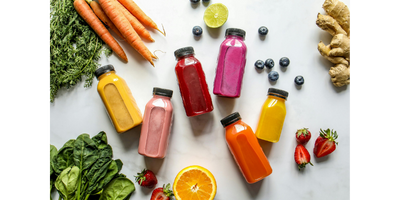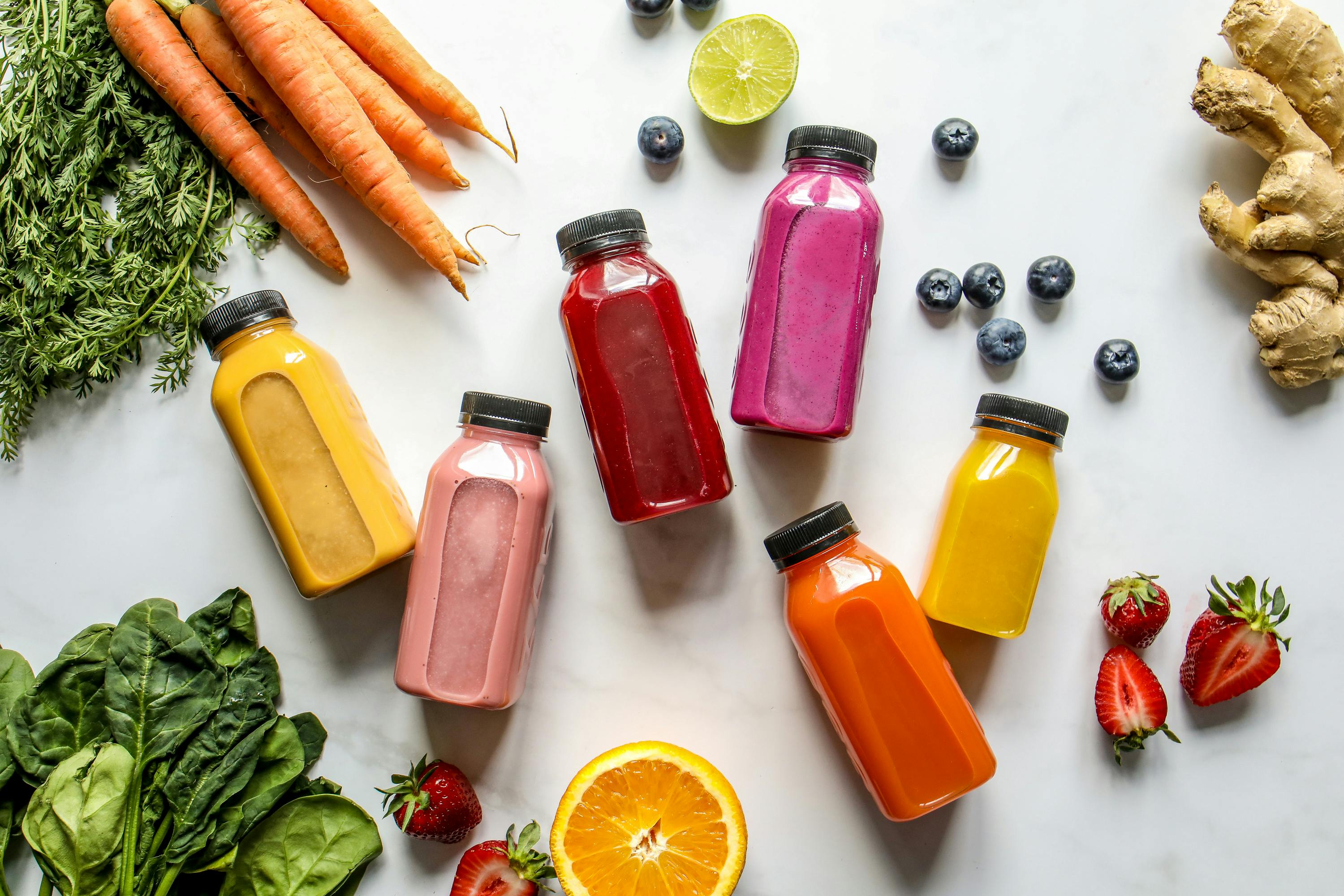Juicing for Inflammation: Natural Recipes and Tips That Work
.png)
It’s truly amazing how effective something as simple as “juice” can have on your body, especially when you’re juicing for inflammation.
Whether you’re juicing at home or browsing the shelves at the local grocery store - you’re typically on the lookout for both flavor and health benefits. Some blends, for example, work complimentary with each other to be more effective / bioactive in general.
For example, studies have shown that the beneficial health compounds found in Turmeric can be 9-10X more bio-available if ingested along with traces of black pepper and a small amount of fat to bond with.

It’s really mind blowing when you think of all the recipes and potential health benefits you can get from freshly extracted juices! Studies are still being done on the specific benefits and health metrics provided by these liquid extracts, but we know for sure that we’re onto something promising.
Let’s take a look at some of the best base ingredients to look for / add into juices to help with inflammation.
Ginger
Let’s start with one of the staples of the cold pressed health juice industry - ginger!
It’s probably not everyone's favorite flavor-wise, but if you can get past the spicy and intensely zingy flavor, you’re in for a world of potential health benefits.
Carrots
Another staple among the juicing community, but with a lot more fans!
.png)
Carrot juice is known to be extremely dense in beneficial compounds such as beta-ceratine, anthocyanins (if they’re purple carrots), Vitamin A, Potassium, and much more.
Pro tip: If you’re juicing large amounts of leafy greens and need something to help bind everything together so that your juicer doesn’t get clogged, consider tossing in a carrot along with your fibrous greens.
Blueberries
Known to be one of the top nutrient dense fruits - along with almost everyone’s favorite berry, blueberries are rich in a wide array of antioxidants and polyphenols.
It’ll add a healthy dose of anthocyanins to your extract as well!
Here’s a few quick recipes for those of you concocting these juices at home:
Ginger-Pinapple Zing
- 1 cup pineapple
- 1-inch piece of ginger
- ½ lemon
- (Optional) Pinch of turmeric and black pepper
Golden Milk (Not a Juice!)
- 1 cup milk
- 1 pinch of turmeric
- 1 pinch of black pepper
Stir in a pot on low heat, strain and serve.
.png)
Carrot Zesty Juice
- 3 medium carrots
- 2 celery stalks
- 1-inch fresh ginger
- ½ lemon (peeled)
Green Glow
- 1 green apple
- 1 cup spinach
- ½ cucumber
- 1 celery stalk
Why Organic?
When it comes to juicing - especially when you’re juicing for inflammation purposes, consider opting for organic produce / ingredients whenever possible.
When you’re juicing you’re literally extracting all the beneficial compounds from your produce into a “concentrate” - dense in everything that the starting produce had, both the good and the bad (pesticides).
.png)
The last thing you want to do is counteract the efforts of your anti inflammatory juice recipe!
There’s something specific we wanted to cover in this article that may not be as well known (you’ll see us repeat this in future articles) - certain cold press juicers have metallic gears that utilize magnets, in order to more effectively extract minerals like iron, manganese, copper, etc. from your produce.
This can work against you if you’re using certain non-organic produce, or anything sprayed with pesticides (they usually contain hazardous heavy metals).
Running produce sprayed with chemicals through a cold press juicer could potentially do more harm than good, especially in the long run.
Consume with Haste
This mostly applies for those of you juicing at home - you’ll want to consume your freshly pressed juices as close to extraction as possible for the maximum health benefits.
Nutrient degradation happens naturally in produce - that degradation process is amplified when those compounds are extracted and left exposed to oxygen / irregular temperatures for long periods of time.
So, drink up right after juicing for the best results!
When you’re picking up fresh juices at the store, always keep the manufacturing / expiration date in mind - you’ll always want to opt for a juice that’s been made recently vs. something that has been sitting for a while.
.png)
As one of our most convincing pieces of evidence, we cite this scientific study that had found that anthocyanin-rich juices/extracts proved to be effective in slowing the progression of cancer within lab mice.
An important note to consider when reviewing this study is the timing of the extraction process and how close it was to consumption.
It’s surprising how significant the degradation of beneficial compounds can become as time progresses - especially if the extract isn’t stored optimally. As we saw in similar studies, lab mice that consumed freshly extracted anthocyanin rich compounds experienced a significantly better effect to their health overall.
Cold Press vs. Blender
Another very important thing to keep in mind when you’re juicing for health benefits is the method of extraction itself.
In summary, a “cold press” juicer produces better quality juice than blenders.
When you toss your ingredients into a blender, it’s using an ultra-fast blade to pulverize everything in the blender. You know how your apple turns brown soon after cutting and leaving it out in the open?
.png)
That’s oxidation, and it happens on the smallest scale too.
Cold pressed juicers are meant to solve this problem of extreme nutrient loss during extraction. Typical juicers have slow gears that “press” your produce at specific speeds / pressures to ensure maximum nutrient retention.
Sure, they can be a little harder to get a hold of vs. a traditional blender, but the benefits are definitely worth it.
Eat a Rainbow of Fruits and Vegetables
Produce comes in all sorts of colors!
Some of the most inspirational and widely used color pigments come from produce, like how the pigment from beets were derived for dyes/paint.
.png)
Colors don’t just add an outward appeal, they can add powerful nutritional benefits too!
Let’s take watermelons for example.
That deep red pigment from a perfectly ripe watermelon is a result of high concentrates of Lyposene. When a watermelon is unripe, it typically has lower amounts (leading to a less intense red color) - but when the melon starts to ripen, the Lyposene concentration goes up too!
Picking out ripe fruits doesn't just give you a better taste / texture, it can be more or less concentrated in beneficial compounds based on how ripe it is!
Bananas are another great example of nutritional bioavailability.
When they’re unripe, they’re more starchy - allowing you to use it in a wide range of culinary uses that you probably couldn’t use a ripe banana with (like boiling unripe bananas). However when they’re just past “ripe” is when they’re supposedly the most nutrient dense.
Anthocyanins, Phycocyanins, and the Importance of Color
Colors lead to diverse arrays of nutritional compounds.
The deep greens and blues given off by fresh / dried blue green spirulina are a result of the presence of “phycocyanins”.
.png)
These phycocyanin compounds aren’t just strong pigments, they’re also considered to be highly dense antioxidants!
Anthocyanins in particular are extremely interesting - they’re the pigments responsible for the dark-red hues in red cabbage, purple carrots, and purple kale.
Some studies have shown that freshly extracted juices containing anthocyanins could potentially have 2-3x the amount of antioxidant active compounds!
So next time you’re at the grocery store and find something with a unique color that you haven’t tried before - consider giving it a chance. If browsing for your regular old white cauliflower, opt for the purple cauliflower if you can find it!




.png)
.png)


